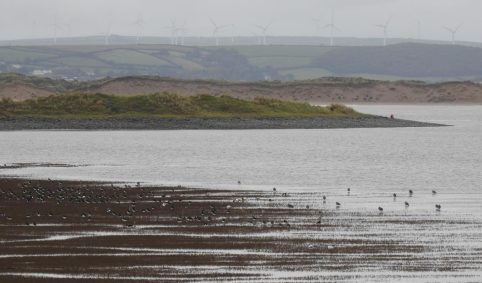A project is gathering pace and taking the next steps to help protect the birdlife that makes the Taw Torridge estuary its home each winter.
Following a survey earlier this year identifying high tide roosts used by birds throughout the winter and looking at how residents and visitors use the estuary and Tarka Trail, a report has been produced explaining the effects of this activity on the over wintering birdlife in the area. The report findings will now be considered to help guide what actions to take next to protect the high tide bird roosts within the area.
North Devon Council, Torridge District Council, Natural England, the Royal Society for the Protection of Birds (RSPB) and the North Devon Areas of Outstanding Natural Beauty (AONB) jointly funded and commissioned this project which they are working on together with the North Devon UNESCO Biosphere Partnership.
Lead Advisor for the North Devon Team at Natural England, Clare Guthrie, says: “The Taw Torridge Estuary Site of Special Scientific Interest (SSSI) is of national importance for its wintering waders and wildfowl. This study will help everyone who enjoys the estuary understand how they can do their bit to help to look after the birds that make it so special.”
Leader Member for the Environment at North Devon Council, Councillor Netti Pearson, says: “The Taw Torridge estuary is an important destination for over-wintering birds, but is also a popular recreational area. This report identifies ways in which the birds are at risk from disturbance arising from the activities of residents and visitors. Thanks are due to everyone who took part in the survey which has led to valuable insights into how the disturbance can be minimised whilst allowing all to enjoy the benefits of this beautiful area.”
Lead Member for the Environment at Torridge District Council, Councillor Ken James, says: “Understanding what species of birds can be found in the area and how their habitats are impacted by human activity is vital so that we can ensure we plan carefully for the future. The recent survey work will allow us to produce a coherent management plan that will ensure that the habitat for wildlife is maintained and even improved, and that people are encouraged to enjoy and use the area responsibly.”
Manager for AONB, Jenny Carey-Wood, says “This report provides strong evidence of the scale of the estuary bird population and a basis for working with visitors and users to better protect key roosting and feeding sites.”
Communications Manager for the RSPB, Tony Whitehead, says: “This report provides the critical evidence that has, until now, been lacking, to show that the Taw Torridge estuary’s nationally important waterbird population is at risk from disturbance. We look forward to working with the councils, Natural England and local businesses and communities to put measures in place to avoid disturbance increasing as the area’s population grows and ensure that people and wildlife can continue to thrive on this beautiful estuary into the future.”
The estuary is designated as a Site of Special Scientific Interest (SSSI) which gives the wintering wildfowl and waders special protection. The report identifies the different causes and frequency of recreational disturbance at each of the sites within the Taw Torridge estuary. It highlights the impacts and possible actions to minimise disturbance such as providing information signs and guidance to protect each of the high tide roosts.
The full report can be found on the council website as well as the websites of the partner organisations involved.
Contact Information
Holly Webbe
holly.webbe@northdevon.gov.uk


